安捷伦 A气相色谱仪作业指导书
安捷伦7820A气相色谱仪作业指导书

XXXX环境监测站安捷伦7820A气相色谱仪作业指导书1.目的为了不断提高和保证全站监测工作质量,规范我站的安捷伦7820A气相色谱仪操作规程,方便分析人员使用、维护仪器。
2.适用范围此作业指导书适用于安捷伦7820A气相色谱仪。
3.操作程序3.1 开机:3.1.1.打开气源(按相应的检测器所需气体,FID需要氮气、氢气和空气)。
3.1.2打开计算机,进入Windows界面。
3.1.3打开7820A GC电源开关。
3.1.4待仪器自检完毕,双击“联机”图标,进入化学工作站,化学工作站自动与7820A 通讯,建立连接。
3.2 7820A配置编辑3.2.1点击“配置”按钮。
在“其他”项目中选择压力单位。
3.1.2柱参数设定点击“色谱柱”按钮,进入柱参数设定画面。
点击前面的数字,对该柱的名称、长度、内径、膜厚、最高使用温度、最低使用温度和该柱的类型进行设置;点击该柱下拉式箭头选择连接的进样口,检测器及加热类型;用“↑”和“↓”在各柱之间进行切换。
3.1.3在“模块”项目中选择后进样口和后检测器尾吹气的种类。
4.在“ALS”项目中输入所用自动进样针的规格。
3.3 测试以及数据采集方法编辑:3.3.1 开始编辑完整方法从“文件”菜单中选择“新建”→“方法”→“确定”。
3.3.2填写自动进样器的参数:点击“”,设置进样体积:0.2uL,溶剂A清洗,进样前清洗4次,进样后清洗4次,体积为最大,溶剂B清洗,进样前清洗4次,进样后清洗4次,体积为最大,样品清洗2次,样品抽吸次数6次,驻留时间,进样前:0分钟,进样后:0分钟,推杆速度:快速,粘度延迟:0秒,采样深度:不启用,进样类型:标准L1气隙0.2uL。
注:上述设置是常用设置,对于不同性质的样品,需要对某些参数进行更改,比如对于粘度较大的样品,需要将进样后驻留时间设为3-5s,同时将粘度延迟设为3-5s3.3.3填写进样口参数:点击“前进样器”或“后进样器”,根据需要填写前进样口或后进样口参数。
(精选文档)安捷伦_7890A气相色谱仪使用说明书

Agilent 7890A气相色谱仪分流/不分流进样(0-100 psi 和 0-150 psi)、填充柱进样、冷柱头进样、程序升温汽化进样口和挥发性物质分析接口内置的 Agilent 7683 自动进样器控制功能。
如要实现高效率、室温顶空、微量液萃取和不同范围的进样体积,您只需简单地添加进样器和样品盘模块即可可选择的进样技术,包括顶空进样、吹扫捕集和阀进样主要特点Agilent 7890A气相色谱仪1突破性的微板流路控制技术实现了柱箱内可靠的无泄漏连接,提高了工作效率和数据完整性,为复杂的GC分析提供了通用、可靠的解决方案2安捷伦仪器监测和智能诊断软件可跟踪配件的使用情况,监测色谱峰形变化,在问题发生之前提醒您进行处理3每个分流/不分流(SSL进样口)都采用了新的方便的扳转式顶盖设计,使您能在30秒内更换进样口衬管 - 无需特殊的工具或培训4品种齐全的选件和附件使您能够配置恰好满足您实验室目前需求的系统, 并能方便地进行升级,以满足不断变化的应用和分析通量的需求²强大的、操作界面友好的GC软件简化了方法设置和系统操作,缩短了培训时间;您可选择正好符合您实验室需求的软件包5在品质卓越的6890进样口, 检测器和GC柱箱上建立的分析方法, 您可以完全放心地将其转移到7890A GC上6其它功能和详细信息请参看仪器样本和资料库中的技术规格文件7填充柱进样、冷柱头进样、程序升温汽化进样口和挥发性物质分析接口内置的 Agilent 7683 自动进样器控制功能进样口两个进样口三个检测器(第三个检测器是TCD)四个检测器信号柱温箱最大升温速率:120°C/min(如使用120 V 电源最大升温速率75°C/min,参见表1)。
•最长运行时间: 999.99 min(16.7 h)。
•柱箱冷却降温( 22°C 室温),从450°C 到50°C 需要4.0 min (采用柱箱插入附件时为3.5 min)电子压力控制范围:0 到100 psig每个EPC单元都使用专用的进样口和检测器选项进行了优化。
安捷伦7820A气相色谱仪作业指导书

XXXX环境监测站安捷伦7820A气相色谱仪作业指导书1.目的为了不断提高和保证全站监测工作质量,规范我站的安捷伦7820A气相色谱仪操作规程,方便分析人员使用、维护仪器。
2.适用范围此作业指导书适用于安捷伦7820A气相色谱仪。
3.操作程序3.1 开机:3.1.1.打开气源(按相应的检测器所需气体,FID需要氮气、氢气和空气)。
3.1.2打开计算机,进入Windows界面。
3.1.3打开7820A GC电源开关。
3.1.4待仪器自检完毕,双击“联机”图标,进入化学工作站,化学工作站自动与7820A 通讯,建立连接。
3.2 7820A配置编辑3.2.1点击“配置”按钮。
在“其他”项目中选择压力单位。
3.1.2柱参数设定点击“色谱柱”按钮,进入柱参数设定画面。
点击前面的数字,对该柱的名称、长度、内径、膜厚、最高使用温度、最低使用温度和该柱的类型进行设置;点击该柱下拉式箭头选择连接的进样口,检测器及加热类型;用“↑”和“↓”在各柱之间进行切换。
3.1.3在“模块”项目中选择后进样口和后检测器尾吹气的种类。
4.在“ALS”项目中输入所用自动进样针的规格。
3.3 测试以及数据采集方法编辑:3.3.1 开始编辑完整方法从“文件”菜单中选择“新建”→“方法”→“确定”。
3.3.2填写自动进样器的参数:点击“”,设置进样体积:0.2uL,溶剂A清洗,进样前清洗4次,进样后清洗4次,体积为最大,溶剂B清洗,进样前清洗4次,进样后清洗4次,体积为最大,样品清洗2次,样品抽吸次数6次,驻留时间,进样前:0分钟,进样后:0分钟,推杆速度:快速,粘度延迟:0秒,采样深度:不启用,进样类型:标准L1气隙0.2uL。
注:上述设置是常用设置,对于不同性质的样品,需要对某些参数进行更改,比如对于粘度较大的样品,需要将进样后驻留时间设为3-5s,同时将粘度延迟设为3-5s3.3.3填写进样口参数:点击“前进样器”或“后进样器”,根据需要填写前进样口或后进样口参数。
安捷伦操作手册 用户指南-Agilent 7820A 气相色谱仪 安全手册 (PDF)
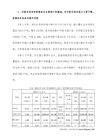
Agilent 7820A 气相色谱仪安全手册声明© Agilent Technologies, Inc. 2009, 2016根据美国和国际版权法,未经 Agilent Technologies, Inc. 事先同意和书面许可,不得以任何形式、任何方式(包括存储为电子版、修改或翻译成外文)复制本手册的任何部分。
手册部件号G4350-97010版本第五版,2016 年 8 月第四版,2015 年 6 月第三版,2011 年 6 月第二版,2009 年 6 月第一版,2009 年 3 月美国和中国印刷Agilent Technologies, Inc.412 Ying Lun RoadWaigoaqiao Freed Trade ZoneShanghai 200131 P.R.China安捷伦科技(上海)有限公司上海市浦东新区外高桥保税区英伦路412号联系电话:(800)820 3278担保说明本手册内容按“原样”提供,在将来的版本中如有更改,恕不另行通知。
此外,在适用法律允许的最大范围内,Agilent 对本手册以及此处包含的任何信息不作任何明示或暗示担保,包括但不仅限于适销性和针对某一特殊用途的适用性的暗示担保。
对于因提供、使用或执行本手册或此处包含的任何信息而产生的错误,或造成的偶然或必然的损失,Agilent 不承担任何责任。
如果安捷伦与用户签订了单独的书面协议,其中涉及本手册内容的担保条款与这些条款冲突,则以协议中的担保条款为准。
技术许可本文档中所述的硬件和/或软件是依据许可提供的,且只能根据此类许可的条款进行使用或复制。
受限权利如果在履行美国政府某项重要合同或转包合同时要使用此软件,将以以下方式提供并授权软件:DFAR 252.227-7014(1995 年 6 月)定义的“商业计算机软件”;FAR2.101 (a) 定义的“商业项目”;FAR 52.227-19(1987 年 6 月)或任何同等机构规定或合同条款定义的“受限计算机软件”。
安捷伦 7890A 气相色谱仪安全手册说明书

Agilent 7890AGas Chromatograph Safety ManualNotices© Agilent Technologies, Inc. 2009, 2011No part of this manual may be reproduced in any form or by any means (including elec-tronic storage and retrieval or translation into a foreign language) without prior agree-ment and written consent from Agilent Technologies, Inc. as governed by United States and international copyright laws. Manual Part NumberG3430-90013EditionFourth edition, June 2011Third edition, May 2009Second edition, December 2007First edition, February 2007Printed in USA and ChinaAgilent Technologies, Inc.2850 Centerville Road Wilmington, DE 19808-1610 USA安捷伦科技(上海)有限公司上海市浦东新区外高桥保税区英伦路412号联系电话:(800)820 3278WarrantyThe material contained in thisdocument is provided “as is,” andis subject to being changed,without notice, in future editions.Further, to the maximum extentpermitted by applicable law,Agilent disclaims all warranties,either express or implied, withregard to this manual and anyinformation contained herein,including but not limited to theimplied warranties ofmerchantability and fitness for aparticular purpose. Agilent shallnot be liable for errors or forincidental or consequentialdamages in connection with thefurnishing, use, or performance ofthis document or of anyinformation contained herein.Should Agilent and the user havea separate written agreementwith warranty terms covering thematerial in this document thatconflict with these terms, thewarranty terms in the separateagreement shall control.Safety NoticesA CAUTION notice denotes ahazard. It calls attention to anoperating procedure, practice, orthe like that, if not correctlyperformed or adhered to, couldresult in damage to the product orloss of important data. Do notproceed beyond a CAUTION noticeuntil the indicated conditions arefully understood and met.A WARNING notice denotes ahazard. It calls attention to anoperating procedure, practice, orthe like that, if not correctlyperformed or adhered to, couldresult in personal injury or death.Do not proceed beyond aWARNING notice until theindicated conditions are fullyunderstood and met.Agilent 7890A Gas ChromatographSafety Manual1IntroductionImportant Safety Warnings 4Hydrogen Safety 7Micro-Electron Capture Detector (µECD) 14 Fuses and Batteries 16Safety and Regulatory Certifications 17 Intended Use 20Cleaning 20Recycling the Product 20IntroductionImportant Safety WarningsBefore moving on, there are several important safety notices that youshould always keep in mind when using the Agilent 7890A GC.When handling/using chemicals for preparation or use within the GC, all applicablelocal and national laboratory safety practices must be followed. This would include,but is not limited to, correct use of Personal Protective Equipment (PPE), correct useof storage vials, and correct handling of chemicals, as defined in the laboratory’sinternal safety analysis and standard operating procedures. Failure to adhere tolaboratory safety practices could lead to injury or death.Many internal parts of the GC carry dangerous voltagesIf the GC is connected to a power source, even if the power switch is off,potentially dangerous voltages exist on:•The wiring between the GC power cord and the AC power supply, the AC power supply itself, and the wiring from the AC power supply tothe power switch.With the power switch on, potentially dangerous voltages also exist on:•All electronics boards in the instrument.•The internal wires and cables connected to these boards.•The wires for any heater (oven, detector, inlet, or valve box).All these parts are shielded by covers. With the covers in place, it should be difficultto accidentally make contact with dangerous voltages. Unless specificallyinstructed to, never remove a cover unless the detector, inlet, or oven are turned off.If the power cord insulation is frayed or worn, the cord must be replaced. Contactyour Agilent service representative.IntroductionDo not use an Uninterruptable Power Supply (UPS) with a GCIf the area where the GC is located suddenly looses power, an unsafecondition can result if the GC remains powered on. Do not use the GCwith a UPS.Electrostatic discharge is a threat to GC electronicsThe printed circuit (PC) boards in the GC can be damaged by electrostaticdischarge. Do not touch any of the boards unless it is absolutelynecessary. If you must handle them, wear a grounded wrist strap and takeother antistatic precautions. Wear a grounded wrist strap any time youmust remove the GC right side cover.Many parts are dangerously hotMany parts of the GC operate at temperatures high enough to causeserious burns. These parts include but are not limited to:•The inlets•The oven and its contents•The detectors•The column nuts attaching the column to an inlet or detector•The valve boxYou should always cool these areas of the GC to room temperature beforeworking on them. They will cool faster if you first set the temperature ofthe heated zone to room temperature. Turn the zone off after it hasreached the setpoint. If you must perform maintenance on hot parts, use awrench and wear thermally protective gloves. Whenever possible, cool thepart of the instrument that you will be maintaining before you beginworking on it.Be careful when working behind the instrument. During cool-down cycles, the GCemits hot exhaust which can cause burns.IntroductionThe insulation around the inlets, detectors, valve box, and the insulation cups ismade of refractory ceramic fibers. To avoid inhaling fiber particles, we recommendthe following safety procedures: ventilate your work area; wear long sleeves,gloves, safety glasses, and a disposable dust/mist respirator; dispose of insulationin a sealed plastic bag; wash your hands with mild soap and cold water afterhandling the insulation.Oven thermal leaksObjects passing through the oven door seal can cause thermal leaks which createhazardous hot spots which cause burns and melt equipment.Do not allow wiring or temperature probes to pass through the oven doorjam. Agilent recommends using one of the access holes.Introduction Hydrogen SafetyHydrogen gas may be used as carrier gas, and/or as fuel for the FID, FPD,and NPD. When mixed with air, hydrogen can form explosive mixtures.When using hydrogen (H2) as the carrier gas or fuel gas, be aware that hydrogengas can flow into the GC oven and create an explosion hazard. Therefore, be surethat the supply is turned off until all connections are made and ensure that the inletand detector column fittings are either connected to a column or capped at all timeswhen hydrogen gas is supplied to the instrument.Hydrogen is flammable. Leaks, when confined in an enclosed space, may create afire or explosion hazard. In any application using hydrogen, leak test allconnections, lines, and valves before operating the instrument. Always turn off thehydrogen supply at its source before working on the instrument.Hydrogen is a commonly used GC carrier gas. Hydrogen is potentiallyexplosive and has other dangerous characteristics.•Hydrogen is combustible over a wide range of concentrations. Atatmospheric pressure, hydrogen is combustible at concentrations from4% to 74.2% by volume.•Hydrogen has the highest burning velocity of any gas.•Hydrogen has a very low ignition energy.•Hydrogen that is allowed to expand rapidly from high pressure into the atmosphere can self-ignite due to an electrostatic spark.•Hydrogen burns with a nonluminous flame which can be invisible under bright light.GC precautionsWhen using hydrogen as a carrier gas, remove the large round plasticcover for the MSD transfer line located on the GC left side panel. In theunlikely event of an explosion, this cover may dislodge.IntroductionHydrogen shutdownHydrogen gas may be used as a carrier or as fuel for some detectors.When mixed with air, hydrogen can form explosive mixtures.The GC monitors inlet and auxiliary gas streams. If a stream shuts downbecause it is unable to reach its flow or pressure setpoint and if thatstream is configured to use hydrogen, the GC assumes that a leak hasoccurred and declares a hydrogen safety shutdown. The effects are:•The offending channel and any associated channels (such as septumpurge) are set off.•The split valves in the split/splitless and PTV inlets open.•The oven (heater and fan) turns off.•The small heated zones are turned off.•An alarm tone sounds.To recover from this state, fix the cause of the shutdown (tank valveclosed, serious leak, others). Turn the instrument off, then back on.The GC cannot always detect leaks in inlet and/or detector gas streams. For thisreason, it is vital that column fittings should always be either connected to acolumn, or have a cap or plug installed. The H2 streams must be configured forhydrogen so that the GC is aware of hydrogen use.IntroductionDangers unique to GC/MSD operationHydrogen presents a number of dangers. Some are general, others areunique to GC or GC/MSD operation. Dangers include, but are not limitedto:•Combustion of leaking hydrogen.•Combustion due to rapid expansion of hydrogen from a high-pressure cylinder.•Accumulation of hydrogen in the GC oven and subsequent combustion (see your GC documentation and the label on the top edge of the GCoven door).•Accumulation of hydrogen in the MSD and subsequent combustion. Hydrogen accumulation in a GC/MSDThe GC/MSD cannot always detect leaks in inlet and/or detector gas streams. Forthis reason, it is vital that column fittings should always be either connected to acolumn, or have a cap or plug installed. The H2 streams must be configured forhydrogen so that the GC is aware of hydrogen use.All users should be aware of the mechanisms by which hydrogen canaccumulate (Table 1) and know what precautions to take if they know orsuspect that hydrogen has accumulated. Note that these mechanisms applyto all mass spectrometers, including the GC/MSD.Table 1Potential hydrogen accumulation mechanisms in GC/MSDMechanism ResultsMass spectrometer turned off A mass spectrometer can be shut downdeliberately. It can also be shut down accidentallyby an internal or external failure. A massspectrometer shutdown does not shut off the flowof carrier gas. As a result, hydrogen may slowlyaccumulate in the mass spectrometer.IntroductionMass spectrometer automated isolation valves closed Some mass spectrometers are equipped with automated diffusion pump isolation valves. In these instruments, deliberate operator action or various failures can cause the isolation valves to close. Isolation valve closure does not shut off the flow of carrier gas. As a result, hydrogen may slowly accumulate in the mass spectrometer.Mass spectrometer manual isolation valves closed Some mass spectrometers are equipped with manual diffusion pump isolation valves. In these instruments, the operator can close the isolation valves. Closing the isolation valves does not shut off the flow of carrier gas. As a result, hydrogen may slowly accumulate in the mass spectrometer.GC off A GC can be shut down deliberately. It can also be shut down accidentally by an internal or external failure. Different GCs react in different ways. If a 7890A GC equipped with Electronic Pressure Control (EPC) is shut off, the EPC stops the flow of carrier gas. If the carrier flow is not under EPC control, the flow increases to its maximum. This flow may be more than some mass spectrometers can pump away, resulting in the accumulation of hydrogen in the mass spectrometer. If the mass spectrometer is shut off at the same time, the accumulation can be fairly rapid.Power failure If the power fails, both the GC and mass spectrometer shut down. The carrier gas, however, is not necessarily shut down. As described previously, in some GCs a power failure may cause the carrier gas flow to be set to maximum. As a result, hydrogen may accumulate in the mass spectrometer.Table 1Potential hydrogen accumulation mechanisms in GC/MSD (continued)Mechanism ResultsPrecautionsTake the following precautions when operating a GC/MSD system with hydrogen carrier gas.Equipment precautionYou MUST make sure the front side-plate thumbscrew is fastenedfinger-tight. Do not overtighten the thumbscrew; it can cause air leaks.Major GC leaks or a column is missing or brokenIf the GC is off and configured for hydrogen, therear oven flap is open to vent out the hydrogen.Proper lab venting, as described in the Site Prepmanual, is recommended. If there is a significantleak, such as a missing column, the GC inlet, PCM,and Aux are provided with flow limiting frits tominimize any hydrogen accumulation within theoven. When the GC is on, major leaks are detectedautomatically.Table 1Potential hydrogen accumulation mechanisms in GC/MSD (continued)Mechanism ResultsOnce hydrogen has accumulated in a system, extreme caution must be used when removing it. Incorrect startup of a system filled with hydrogen can cause an explosion.After a power failure, the mass spectrometer may start up and begin the pumpdown process by itself. This does not guarantee that all hydrogen has been removed from the system or that the explosion hazard has been removed.Failure to secure your MSD as described above greatly increases the chance of personal injury in the event of an explosion.You must remove the plastic cover over the glass window on the front of a 5975 MSD. In the unlikely event of an explosion, this cover may dislodge.General laboratory precautions•Avoid leaks in the carrier gas lines. Use leak-checking equipment to periodically check for hydrogen leaks.•Eliminate from your laboratory as many ignition sources as possible (open flames, devices that can spark, sources of static electricity, etc.).•Do not allow hydrogen from a high pressure cylinder to vent directly to atmosphere (danger of self-ignition).•Use a hydrogen generator instead of bottled hydrogen.•Provide proper system ventilation as described in the Site Prep manual. Operating precautions•Turn off the hydrogen at its source every time you shut down the GC or MSD.•Turn off the hydrogen at its source every time you vent the MSD (do not heat the capillary column without carrier gas flow).•Turn off the hydrogen at its source every time isolation valves in an MSD are closed (do not heat the capillary column without carrier gas flow).•Turn off the hydrogen at its source if a power failure occurs.•If a power failure occurs while the GC/MSD system is unattended, even if the system has restarted by itself:1Immediately turn off the hydrogen at its source.2Turn off the GC.3Turn off the MSD and allow it to cool for 1 hour.4Eliminate all potential sources of ignition in the room.5Open the vacuum manifold of the MSD to atmosphere.6Wait at least 10 minutes to allow any hydrogen to dissipate.7Start up the GC and MSD as normal.When using hydrogen gas, check the system for leaks to prevent possiblefire and explosion hazards based on local Environmental Health andSafety (EHS) requirements. Always check for leaks after changing a tankor servicing the gas lines. Always make sure the vent line is vented into afume hood.Measuring hydrogen gas flowsDo not measure hydrogen together with air or oxygen. This can create explosivemixtures that may be ignited by the automatic ignitor.To avoid this hazard:Turn the automatic ignitor off before you begin.Always measure gases separately.When measuring gas flows on a detector using hydrogen for the detectorflame or carrier gas, measure the hydrogen flow separately. Never allowan air stream to enter when hydrogen is present in the flow meter.Micro-Electron Capture Detector (µECD)The µECD contains a cell plated with 63Ni, a radioactive isotope. The betaparticles released at the energy level in the detector have little penetratingpower—the surface layer of the skin or a few sheets of paper will stopmost of them—but they may be hazardous if the isotope is ingested orinhaled. For this reason, handle the cell with care. Cap the detector inletand outlet fittings when the detector is not in use. Never introducecorrosive chemicals into the detector. Vent detector exhaust outside thelaboratory environment.Refer to the safety documentation provided with the detector forimportant details about safety, maintenance, and compliance with localgovernment regulation.Materials that may react with the 63Ni source, either to form volatile products or tocause physical degradation of the plated film, must be avoided. These materialsinclude oxidizing compounds, acids, wet halogens, wet nitric acid, ammoniumhydroxide, hydrogen sulfide, PCPs, and carbon monoxide. This list is not exhaustivebut indicates the kinds of compounds that may cause damage to 63Ni detectors.In the extremely unlikely event that the oven or the detector-heated zone should gointo thermal runaway (maximum, uncontrolled heating in excess of 400 °C) and thedetector remains exposed to this condition for more than 12 hours, take thefollowing steps:1After turning off the main power and allowing the instrument to cool to roomtemperature, cap the detector inlet and exhaust vent openings. Wear disposableplastic gloves and observe normal laboratory safety precautions.2Contact your local Agilent Technologies sales office or distributor for ECD disposal instructions3Include a letter stating the condition of abuse.It is unlikely, even in this very unusual situation, that radioactive material willescape the cell. However, permanent damage to the 63Ni plating within the cell ispossible; therefore, the cell must be returned for exchange.Do not use solvents to clean the µECD.You may not open the µECD cell unless authorized to do so by your local nuclear regulatory agency. Do not disturb the four socket-head bolts. These hold the cell halves together. United States customers removing or disturbing them is a violation of the terms of the exemption and could create a safety hazard.When handling µECDs:•Never eat, drink, or smoke.•Always wear safety glasses when working with or near open µECDs.•Wear protective clothing such as laboratory jackets, safety glasses, and gloves, and follow good laboratory practices. Wash hands thoroughly with a mild nonabrasive cleaner after handling µECDs.•Cap the inlet and outlet fittings when the µECD is not in use.•Connect the µECD exhaust vent to a fume hood or vent it to the outside. See the latest revision of 10 CFR Part 20 (including AppendixB), or the applicable state regulation. For other countries, consult withthe appropriate agency for equivalent requirements.Agilent Technologies recommends a vent line internal diameter of 6 mm (1/4-inch) or greater. With a line of this diameter, the length is not critical.Fuses and BatteriesThe GC requires fuses and batteries for proper operation. These must onlybe accessed by Agilent trained service personnel.Table 2AC board fusesFuse designation Line voltage Fuse rating and typeF1, F2All20 A, 250 Vac, IEC 127 type f (non-time delay),ceramic bodyF3, F4All8 A, 250 Vac, IEC type f (non-time delay),glass bodyTable 3Logic board batteryBattery designation Battery rating and typeBT13-volt lithium-poly carbon battery, .048A-HR,Panasonic model BR 1225Safety and Regulatory CertificationsThe Agilent 7890A GC conforms to the following safety standards:•Canadian Standards Association (CSA): C22.2 No. 1010.1•CSA/Nationally Recognized Test L aboratory (NRTL): UL 61010•International Electrotechnical Commission (IEC): 61010–1•EuroNorm (EN): 61010–1The Agilent 7890A GC conforms to the following regulations onElectromagnetic Compatibility (EMC) and Radio Frequency Interference(RFI):•CISPR 11/EN 55011: Group 1, Class A•IEC/EN 61326•AUS/NZThis ISM device complies with Canadian ICES-001. Cet appareil ISM estconforme a la norme NMB—001 du Canada.The Agilent 7890A GC is designed and manufactured under a qualitysystem registered to ISO 9001.Instructions for Disposal of Waste Equipment by Users in the EuropeanUnion. This symbol on the product or its packaging indicates that thisproduct must not be disposed of with other waste. Instead, it is yourresponsibility to dispose of your waste equipment by handing it over to adesignated collection point for the recycling of waste electrical andelectronic equipment. The separate collection and recycling of your wasteequipment at the time of disposal will help conserve natural resources andensure that it is recycled in a manner that protects human health and theenvironment. For more information about where you can drop off yourwaste equipment for recycling, please contact your local city recyclingoffice or the dealer from whom you originally purchased the product.InformationThe Agilent Technologies 7890A Gas Chromatograph meets the followingIEC (International Electro-technical Commission) classifications: SafetyClass I, Transient Overvoltage Category II, Pollution Degree 2.This unit has been designed and tested in accordance with recognizedsafety standards and is designed for use indoors in non-classifiedlocations. If the instrument is used in a manner not specified by themanufacturer, the protection provided by the instrument may be impaired.Whenever the safety protection of the Agilent 7890A Gas Chromatographhas been compromised, disconnect the unit from all power sources andsecure the unit against unintended operation.Refer servicing to qualified service personnel. Substituting parts orperforming any unauthorized modification to the instrument may result ina safety hazard.SymbolsWarnings in the manual or on the instrument must be observed during allphases of operation, service, and repair of this instrument. Failure tocomply with these precautions violates safety standards of design and theintended use of the instrument. Agilent Technologies assumes no liabilityfor the customer’s failure to comply with these requirements.See accompanying instructions for moreinformation.Indicates a hot surface.Indicates hazardous voltages.Indicates earth (ground) terminal.Indicates potential explosion hazard.Electromagnetic compatibilityThis device complies with the requirements of CISPR 11. Operation is subject to the following two conditions:•This device may not cause harmful interference.•This device must accept any interference received, includinginterference that may cause undesired operation.If this equipment does cause harmful interference to radio or television reception, which can be determined by turning the equipment off and on, the user is encouraged to try one or more of the following measures:1Relocate the radio or antenna.2Move the device away from the radio or television.3Plug the device into a different electrical outlet, so that the device and the radio or television are on separate electrical circuits.4Make sure that all peripheral devices are also certified.5Make sure that appropriate cables are used to connect the device to peripheral equipment.6Consult your equipment dealer, Agilent Technologies, or an experienced technician for assistance.7Changes or modifications not expressly approved by AgilentTechnologies could void the user’s authority to operate the equipment.Indicates radioactivity hazard.Indicates electrostatic discharge hazard.Indicates a hazard. See the Agilent 7890A GC user documentation for the itemlabeled.Indicates that you must not discard thiselectrical/electronic product in domestichousehold wasteSound Emission Certification for Federal Republic of GermanySound pressureSound pressure L p < 70 dB(A) according to DIN-EN 27779.SchalldruckpegelSchalldruckpegel L P < 70 dB(A) nach DIN-EN 27779.Intended UseAgilent products must only be used in the manner described in theAgilent product user guides. Any other use may result in damage to theproduct or personal injury. Agilent is not responsible for any damagescaused, in whole or in part, by improper use of the products,unauthorized alterations, adjustments or modifications to the products,failure to comply with procedures in Agilent product user guides, or useof the products in violation of applicable laws, rules or regulations. CleaningTo clean the unit, disconnect the power and wipe down with a damp,lint-free cloth.Recycling the ProductFor recycling, contact your local Agilent sales office.。
7890A型安捷伦 气相操作手册

转贴一个7890A的安捷伦7890A的操作规程(供参考)1、目的:建立安捷伦7890A型气相色谱仪标准操作程序。
2、范围:适用于Agilent 7890A,FID检测器及Chemstation软件的气相色谱仪。
3、责任者:操作者4、程序:4.1 操作前准备4.1.1 色谱柱的检查与安装首先打开柱温箱门看是否是所需用的色谱柱,若不是则旋下毛细管柱按进样口和检测器的螺母,卸下毛细管柱。
取出所需毛细管柱,放上螺母,并在毛细管柱两端各放一个石墨环,然后将两侧柱端截去1~2cm,进样口一端石墨环和柱末端之间长度为4~6mm,检测器一端将柱插到底,轻轻回拉1mm左右,然后用手将螺母旋紧,不需用板手,新柱老化时,将进样口一端接入进样器接口,另一端放空在柱温箱内,检测器一端封住,新柱在低于最高使用温度20~30℃以下,通过较高流速载气连续老化2小时以上。
4.1.2 气体流量的调节4.1.2.1 载气(N2 or He)开启氮气钢瓶高压阀前,首先检查低压阀的调节杆应处于释放状态,打开高压阀,缓缓旋动低压阀的调节杆,调节至约0.4~0.6MPa。
4.1.2.2 氢气打开氢气钢瓶or氢气发生器主阀,调节输出压至0.4MPa。
4.1.2.3 空气启动的空气压主机,调节输出压至0.4MPa。
4.1.3 检漏用检漏液检查柱及管路是否漏气。
4.2 主机操作4.2.1 接通电源,打开电脑,进入英文windows xp主菜单界面。
然后开启主机,主机进行自检,自检通过主机屏幕显示power on successul,进入Windows系统后,双击电脑桌面的(Instrument Online)图标,使仪器和工作联接。
4.2.2 编辑新方法4.2.2.1 从“Method”菜单中选择“Edit Entire Method”,根据需要钩选项目,“Method Information”(方法信息),“Instrument/Acquisition”(仪器参数/数据采集条件),“Data Analysis”(数据分析条件),“Run Time Checklist”(运行时间顺序表),确定后单击“OK”。
安捷伦A操作规程
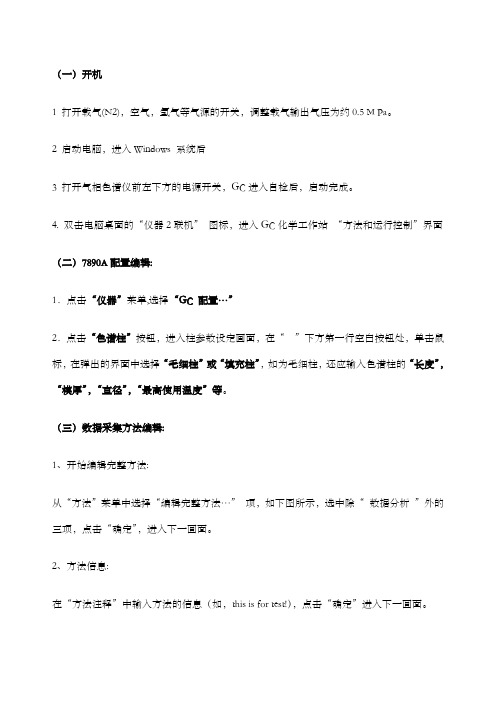
(一)开机1 打开载气(N2),空气,氢气等气源的开关,调整载气输出气压为约0.5 M Pa。
2 启动电脑,进入Windows 系统后3 打开气相色谱仪前左下方的电源开关,GC进入自检后,启动完成。
4. 双击电脑桌面的“仪器2联机”图标,进入GC化学工作站“方法和运行控制”界面(二)7890A配置编辑:1.点击“仪器”菜单,选择“GC 配置…”2.点击“色谱柱”按钮,进入柱参数设定画面,在“”下方第一行空白按钮处,单击鼠标,在弹出的界面中选择“毛细柱”或“填充柱”,如为毛细柱,还应输入色谱柱的“长度”,“模厚”,“直径”,“最高使用温度”等。
(三)数据采集方法编辑:1、开始编辑完整方法:从“方法”菜单中选择“编辑完整方法…”项,如下图所示,选中除“数据分析”外的三项,点击“确定”,进入下一画面。
2、方法信息:在“方法注释”中输入方法的信息(如,this is for test!),点击“确定”进入下一画面。
3、进样器设置:在“选择进样源/位置”画面中选择“GC 进样器”,并选择所用的进样口的物理位置(前或后)。
点击“确定”,进入下一画面。
4、柱模式(CFT)设定:点击“”图标,进入柱模式设定画面,选择控制模式,“流速”或“压力”。
如:压力,25 psi;或流速,6.5ml/min。
5、分流不分流进样口参数设定:点击“”图标,进入进样口设定画面。
点击“模式”右方的下拉式箭头,选择进样方式为“不分流”(或分流方式,分流)。
输入进样口的温度(如250℃),输入隔垫吹扫流量(如3ml/min)。
在“分流出口吹扫流量”下边的空白框内输入吹扫流量(如0.75min 后60ml/min); 如选择分流方式, 则要输入“分流比”。
6、柱温箱温度参数设定:点击“”图标,进入柱温参数设定。
在空白表框内输入温度,选中“柱温箱温度为开”左边的方框;℃/min—升温速率;输入合适的升温参数。
7、FID检测器参数设定:点击“”图标,进入检测器参数设定。
安捷伦7820A气相色谱仪操作规程

XXXXXX 检测有限公司7820A 气相色谱仪操作规程文件编号: GFHD-Wb48 编 制: ____________________ 审 核: ____________________ 批 准: ____________________文件控制印章受控编号: 生效日期:2017年6月1日版 次: A.0日 期:2017年6月1日 日 期:2017年6月1日 日 期:2017年6月1日文件修订履历1仪器用途7820A气相色谱仪主要用于有机化学实验的定量和定性分析。
2仪器工作原理气相色谱仪根据试样中各组分在色谱柱中的气相和固定相间的分配系数不同,当汽化后的试样被载气带入色谱柱中运行时,组分就在其中的两相间进行反复多次(103-106)的分配(吸附一脱附一放出),由于固定相对各种组分的吸附能力不同(即保存作用不同),因此各组份在色谱柱中的运行速度就不同,经过一定的柱长后,便彼此分离;分离后的组分按保留时间的先后顺序进入检测器,检测器根据组份的物理化学性质将组份按顺序检测出来并自动记录检测信号,产生的信号经放大后,在记录器上描绘出各组分的色谱峰;最终依据试样中各组分保留时间(出峰位置)进行定性分析或依据响应值(峰高或峰面积)对试样中各组分进行定量分析。
它主要有五个部分组成:载气源、进样口、色谱柱、检测器、数据处理。
3仪器主要技术性能♦柱温箱尺寸:28.0X30.5X 16.5 cm温度范围:室温以上8℃一425℃温度设定值精度:1℃最快升温速率:75℃/分钟50〜70℃,升温速率:75℃/分钟 70〜115℃,升温速率:45℃/分钟 115〜175℃,升温速率:40℃/分钟175〜300℃,升温速率:30℃/分钟300〜425℃,升温速率:20℃/分钟最长运行时间:999.99分钟程序升温:5阶温度精度:室温每波动1° C,柱温箱的温度波动<0.01° C柱温箱程序升温精度:W2%程序升温重现性:W1%♦进样口最多能安装两个进样口可安装:填充柱进样口和分流/不分流进样口分流/不分流进样口(S/SL)电子压力/流量控制最高使用温度400。
安捷伦7820A操作规程

安捷伦7820A操作规程安捷伦7820A气相色谱仪江苏省优联检测技术服务有限公司作业指导书操作规程安捷伦7820A气相色谱仪操作规程目的规范7820A型气相色谱仪的使用。
范围适用于7820A型气相色谱仪的使用。
一、开机:1. 打开气源,按相应的检测器所需气体,。
2. 打开计算机~进入Windows界面。
3. 打开7820GC电源开关。
4. 待仪器自检完毕~双击“”图标~进入化学工作站~双击GC7820A~化学工作站自动与7820A通讯~建立连接。
二、7820A配置编辑1( 双击“安捷伦7820A GC”~弹出EZChrom配置对话框。
在IP地址栏输入仪器的GC名称和IP地址~然后点击“获得GC配置”。
当显示已成功连接到GC配置可用的时候~证明软件已经成功的连接到了GC上~并且已经成功获取仪器的配置。
2( 在“EZChrom配置”对话框中点击“配置”按钮。
在“其他”项目中选择压力单位~输入柱子的最大耐高温度。
3. 确认色谱柱窗口中的配置和实际安装的情况相符。
柱参数设定点击“色谱柱”按钮~进入柱参数设定画面~进入“从目录选择色谱柱1”画面~点击“向目录添加色谱柱”按钮进入柱库~从柱库中选择要添加的色谱柱~然后点击“确定”~点击该柱下拉式箭头选择连接的进样口~检测器及加热类型。
4( 在“自动进样器”项目中输入“10μl”作为注射器规格。
点击“确定” 退出配置画面。
二、数据采集方法编辑:1. 开始编辑完整方法从“文件”菜单中选择“方法”…\“新建”或选择新建方法。
2. 从“视图”菜单选择“浏览窗口”~然后在“方法”视窗中点击“仪器设置”。
3. 填写自动进样器的参数:编号: 编制:王蕊第0次修改第 1 页?共 4 页审核: 修改: 发布日期: 年月日批准: 批准:安捷伦7820A气相色谱仪江苏省优联检测技术服务有限公司作业指导书操作规程点击“”设置进样体积:1ul~溶剂A清洗~进样前清洗4次~进样后清洗4次~体积为最大~样品清洗2次~样品抽吸次数6次~驻留时间~进样前:0分钟~进样后:0分钟~推杆速度:快速~粘度延迟:0秒~采样深度:不启用~进样类型:标准 L1气隙 0.2ul。
安捷伦_7890A气相色谱仪使用说明书范文
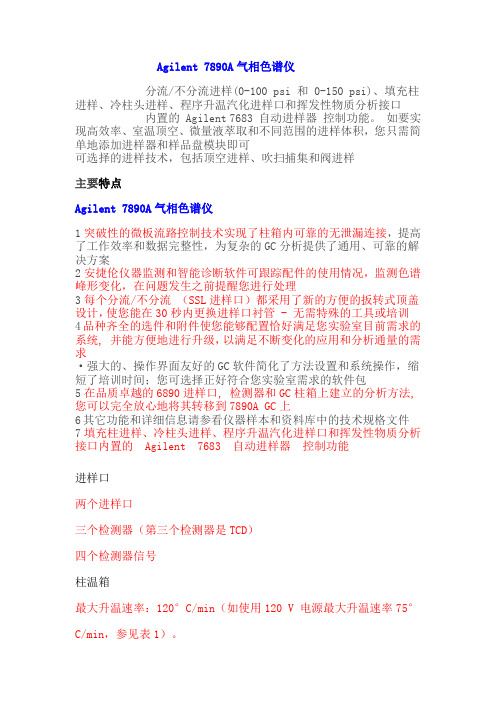
Agilent 7890A气相色谱仪分流/不分流进样(0-100 psi 和 0-150 psi)、填充柱进样、冷柱头进样、程序升温汽化进样口和挥发性物质分析接口内置的 Agilent 7683 自动进样器控制功能。
如要实现高效率、室温顶空、微量液萃取和不同范围的进样体积,您只需简单地添加进样器和样品盘模块即可可选择的进样技术,包括顶空进样、吹扫捕集和阀进样主要特点Agilent 7890A气相色谱仪1突破性的微板流路控制技术实现了柱箱内可靠的无泄漏连接,提高了工作效率和数据完整性,为复杂的GC分析提供了通用、可靠的解决方案2安捷伦仪器监测和智能诊断软件可跟踪配件的使用情况,监测色谱峰形变化,在问题发生之前提醒您进行处理3每个分流/不分流(SSL进样口)都采用了新的方便的扳转式顶盖设计,使您能在30秒内更换进样口衬管 - 无需特殊的工具或培训4品种齐全的选件和附件使您能够配置恰好满足您实验室目前需求的系统, 并能方便地进行升级,以满足不断变化的应用和分析通量的需求·强大的、操作界面友好的GC软件简化了方法设置和系统操作,缩短了培训时间;您可选择正好符合您实验室需求的软件包5在品质卓越的6890进样口, 检测器和GC柱箱上建立的分析方法, 您可以完全放心地将其转移到7890A GC上6其它功能和详细信息请参看仪器样本和资料库中的技术规格文件7填充柱进样、冷柱头进样、程序升温汽化进样口和挥发性物质分析接口内置的Agilent 7683 自动进样器控制功能进样口两个进样口三个检测器(第三个检测器是TCD)四个检测器信号柱温箱最大升温速率:120°C/min(如使用120 V 电源最大升温速率75°C/min,参见表1)。
•最长运行时间: 999.99 min(16.7 h)。
•柱箱冷却降温( 22°C 室温),从450°C 到50°C 需要4.0 min (采用柱箱插入附件时为3.5 min)电子压力控制范围:0 到100 psig每个EPC单元都使用专用的进样口和检测器选项进行了优化。
安捷伦6890A说明书

十一、HP-6890气相色谱仪操作规程1、操作参数(天然气组分分析)2、设备图片11、电源开关2、操作面板3、显示屏3、操作方法3.1方法提要将具有代表性的气样和已知组成的标准气样,在同样的操作条件下,用HP6890气相色谱仪进行分离,将二者相应的各组分进行比较,用标气的组成数据计算出所测气样相应的组份含量。
3.2分析前准备工作3.2.1检查电源线,各气路管线连接是否正确;3.2.2打开氩气钢瓶总阀,调节压力0.5--0.7Mpa,同时检查导气管的密闭性;3.2.3打开辅助气体发生器电源(Air、H2),同时检查导气管的密闭性;3.2.4开启色谱仪电源,等色谱自检完毕后打开工作站,进入在线状态;3.2.5在方法与运行控制画面(Method & Run control)下打开仪器(instrument)菜单,点击编辑参数(Edit Parameter),在此状态下,按“操作参数”设置所有参数,同时启动加热(Heater)、点火(Flame)、点灯丝(Filament)等功能,最后点击应用(Apply)。
3.2.6所有参数设置完毕后,等待仪器稳定(仪器稳定的标准是运行与控制画面中的红色状态栏(Not Ready)变绿(Ready)。
同时看氢火焰与热导的信号值是否在规定值左右,若信号值太高则需老化柱子)。
3.3测量3.3.1校正因子的分析操作1)打开运行控制菜单(Run control),点击样品设置(Sample Info)在信号1(Signal1)和样品名(Sample Name)处填写要做气样的名称,完毕点击“OK”。
2)在仪器稳定后,按下色谱仪右侧键盘上的预运行(Pre Run),待机子重新稳定后由进样口进入适量标准气样(一定要将气管、柱子内的气体置换完全),立即按下色谱仪键盘上的开始键(Start),让仪器开始运行。
3)所有峰出完后,在方法与运行控制状态栏下选择数据分析(Data Analysis)栏,打开校正菜单(Calibration),点击新建校正表(New Calibration Table),在自动建立(Aotomatic setup)处选择校正级数(Level)1,单击“OK”,在校正表(Calibration Table)中加入和所出谱图中时间相对应的峰的化合物名称,并在百分含量(Amt%)栏输入相应化合物的百分含量。
完整word版安捷伦7820A操作规程
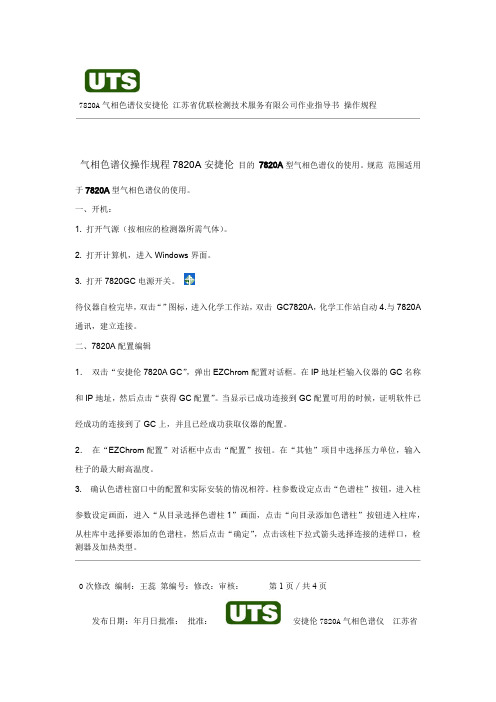
7820A气相色谱仪安捷伦江苏省优联检测技术服务有限公司作业指导书操作规程气相色谱仪操作规程7820A安捷伦目的7820A型气相色谱仪的使用。
规范范围适用于7820A型气相色谱仪的使用。
一、开机:1.打开气源(按相应的检测器所需气体)。
2.打开计算机,进入Windows界面。
3.打开7820GC电源开关。
待仪器自检完毕,双击“”图标,进入化学工作站,双击GC7820A,化学工作站自动4.与7820A 通讯,建立连接。
二、7820A配置编辑1.双击“安捷伦7820A GC”,弹出EZChrom配置对话框。
在IP地址栏输入仪器的GC名称和IP地址,然后点击“获得GC配置”。
当显示已成功连接到GC配置可用的时候,证明软件已经成功的连接到了GC上,并且已经成功获取仪器的配置。
2.在“EZChrom配置”对话框中点击“配置”按钮。
在“其他”项目中选择压力单位,输入柱子的最大耐高温度。
3. 确认色谱柱窗口中的配置和实际安装的情况相符。
柱参数设定点击“色谱柱”按钮,进入柱参数设定画面,进入“从目录选择色谱柱1”画面,点击“向目录添加色谱柱”按钮进入柱库,从柱库中选择要添加的色谱柱,然后点击“确定”,点击该柱下拉式箭头选择连接的进样口,检测器及加热类型。
0次修改编制:王蕊第编号:修改:审核:第1页∕共4页发布日期:年月日批准:批准:安捷伦7820A气相色谱仪江苏省优联检测技术服务有限公司作业指导书操作规程4.在“自动进样器”项目中输入“10μl”作为注射器规格。
点击“确定”退出配置画面。
二、数据采集方法编辑:1.开始编辑完整方法从“文件”菜单中选择“方法”…\“新建”或选择新建方法。
2.从“视图”菜单选择“浏览窗口”,然后在“方法”视窗中点击“仪器设置”。
3.填写自动进样器的参数:点击“”设置进样体积:1ul,溶剂A清洗,进样前清洗4次,进样后清洗4次,体积为最大,样品清洗2次,样品抽吸次数6次,驻留时间,进样前:0分钟,进样后:0分钟,推杆速度:快速,粘度延迟:0秒,采样深度:不启用,进样类型:标准L1气隙0.2ul。
64安捷伦气相6890作业指导书
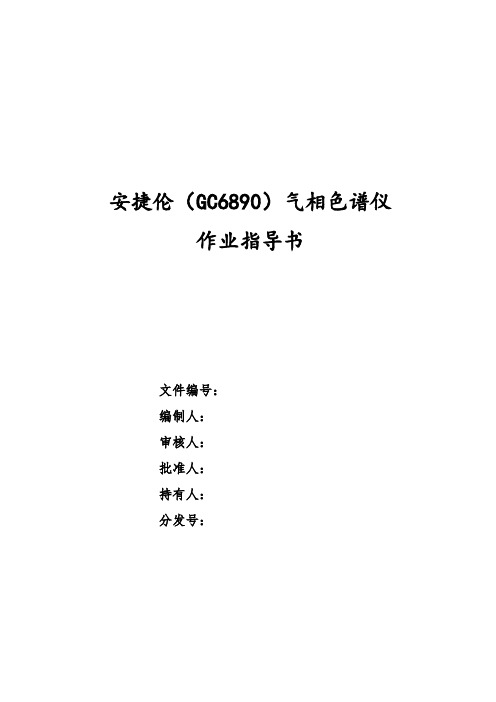
安捷伦(GC6890)气相色谱仪作业指导书文件编号:编制人:审核人:批准人:持有人:分发号:1.目的规范安捷伦(GC6890)气相色谱仪开关机注意事项,正确操作和使用仪器,保证检测工作顺利进行,操作员人身安全和设备安全。
2.适用范围适用于安捷伦(GC6890)气相色谱仪的使用操作。
3.职责3.1使用人员:按照本作业指导书,正确对仪器使用、维护,做使用登记。
3.2保管人员:负责对仪器进行定期维护、保养。
3.3设备管理员:负责仪器综合管理。
4.操作规程4.1开机前的准备工作开机前必须进行开机前各项准备工作,以保证仪器正常使用,延长仪器使用寿命。
4.1.1气路检漏6890开机前需进行气路检漏测试,可通过皂液检漏,确保载气、燃气、助燃气及辅助气气路无泄漏,尤其是用到ECD检测器时候,必须严格检漏防止空气进入,防止对柱子及检测器造成不可修复的影响。
4.1.2进样口及进样塔相关检查在仪器开机前,需对仪器进样口各个构件及7683进样塔进行检查,包括但不限于:隔垫是否需要更换;所用衬管是否与进样方式相对应;进样针推杆是否阻塞;进样塔中溶剂瓶及废液瓶是否需要更换或者清理;检查色谱柱是否正常连接等等。
4.2开机操作分析样品前应按照正常顺序进行开机操作4.2.1打开气路:首先,将对应的载气钢瓶总阀打开,调节减压阀使其压力控制在0.4~0.6MPa左右,若用到FID检测器则还需打开氢气发生器及空气压缩机。
4.2.2开机,打开仪器左下角电源开关键,此时,仪器各部分开始进行自检,待样品盘、进样塔、仪器本身自检通过后,打开桌面上的,等待软件启动成功。
如果提示方法不一致,则需先点确定,然后按照“打开气路——设置其他部分——点击确定”一步步操作,完成后进入联机界面。
第 1 页共6 页注:如果想采集数据的话,第一个打开的软件必须是联机软件。
如果是打开的脱机界面的话,则需要先将脱机软件关闭后,才能打开联机软件进行数据的采集,不能在脱机界面打开但联机界面未打开的情况下去打开联机软件。
安捷伦7890A气相色谱仪使用说明书

Agilent 7890A气相色谱仪分流/不分流进样(0-100 psi 和 0-150 psi)、填充柱进样、冷柱头进样、程序升温汽化进样口和挥发性物质分析接口内置Agilent 7683 自动进样器控制功能。
如要实现高效率、室温顶空、微量液萃取和不同范围的进样体积,您只需简单地添加进样器和样品盘模块即可。
可选择的进样技术,包括顶空进样、吹扫捕集和阀进样主要特点Agilent 7890A气相色谱仪1突破性的微板流路控制技术实现了柱箱内可靠的无泄漏连接,提高了工作效率和数据完整性,为复杂的GC分析提供了通用、可靠的解决方案2安捷伦仪器监测和智能诊断软件可跟踪配件的使用情况,监测色谱峰形变化,在问题发生之前提醒您进行处理3每个分流/不分流(SSL进样口)都采用了新的方便的扳转式顶盖设计,使您能在30秒内更换进样口衬管 - 无需特殊的工具或培训4品种齐全的选件和附件使您能够配置恰好满足您实验室目前需求的系统, 并能方便地进行升级,以满足不断变化的应用和分析通量的需求·强大的、操作界面友好的GC软件简化了方法设置和系统操作,缩短了培训时间;您可选择正好符合您实验室需求的软件包5在品质卓越的6890进样口, 检测器和GC柱箱上建立的分析方法,您可以完全放心地将其转移到7890A GC上6其它功能和详细信息请参看仪器样本和资料库中的技术规格文件7填充柱进样、冷柱头进样、程序升温汽化进样口和挥发性物质分析接口内置的Agilent 7683 自动进样器控制功能进样口两个进样口三个检测器(第三个检测器是TCD)四个检测器信号柱温箱最大升温速率:120°C/min(如使用120 V 电源最大升温速率75°C/min,参见表1)。
•最长运行时间: 999.99 min(16.7 h)。
•柱箱冷却降温( 22°C 室温),从450°C 到50°C 需要4.0 min(采用柱箱插入附件时为3.5 min)电子压力控制范围:0 到100 psig每个EPC单元都使用专用的进样口和检测器选项进行了优化。
安捷伦 Agilent 7820A气相色谱仪 说明书

Agilent Technologies
13
2 ALS 和检测器症状
推杆错误
如果 ALS 报告前推杆或后推杆错误,请检查以下可能原因: • 进样针推杆被粘住或未牢固地连接到推杆支架。
14
故障排除
ALS 和检测器症状 2
进样针针头在向进样口中注射的过程中发生弯曲
警告
排除进样器的故障时,您的手需远离进样针针头。针头很锋 利,还可能包含危险化学制品。
10
故障排除
概念和常规任务 1
电话联系 Agilent 寻求服务之前要获得的信息
电话联系 Agilent 寻求服务之前请收集以下信息: • 症状 • 问题说明 • 发生错误时所安装的硬件以及参数 / 配置 (样品、供气类型、
气流速率、所安装的检测器 / 进样口等等) • GC 显示屏上显示的所有消息 • 已运行的所有故障排除测试的结果 • 仪器详细信息。请获取下列信息:
FID 火焰在运行过程中熄灭并尝试重新点燃
37
FID 基线输出大于 20 pA 38
NPD 溶剂淬火
39
NPD 响应低
40
NPD 基线输出大于 8 百万
41
NPD 调整补偿值过程运行不正常
42
NPD 选择性低
43
对 TCD 发现负峰
44
TCD 基线已经抑制了正弦曲线噪音拖尾峰 (振荡基线)
TCD 峰在尾部有负向斜行线
手册部件号
G4350-97015
版本
第一版, 2009 年 3 月
中国印刷
Agilent Technologies (Shanghai) Co., Ltd. 412 Ying Lun Road Waigaogiao Free Trade Zone Shanghai 200131 P.R. China
安捷伦7820A气相色谱仪操作规程
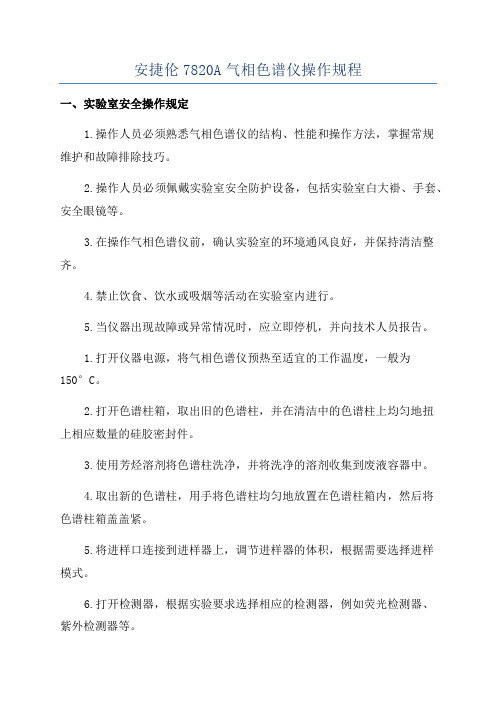
安捷伦7820A气相色谱仪操作规程一、实验室安全操作规定1.操作人员必须熟悉气相色谱仪的结构、性能和操作方法,掌握常规维护和故障排除技巧。
2.操作人员必须佩戴实验室安全防护设备,包括实验室白大褂、手套、安全眼镜等。
3.在操作气相色谱仪前,确认实验室的环境通风良好,并保持清洁整齐。
4.禁止饮食、饮水或吸烟等活动在实验室内进行。
5.当仪器出现故障或异常情况时,应立即停机,并向技术人员报告。
1.打开仪器电源,将气相色谱仪预热至适宜的工作温度,一般为150°C。
2.打开色谱柱箱,取出旧的色谱柱,并在清洁中的色谱柱上均匀地扭上相应数量的硅胶密封件。
3.使用芳烃溶剂将色谱柱洗净,并将洗净的溶剂收集到废液容器中。
4.取出新的色谱柱,用手将色谱柱均匀地放置在色谱柱箱内,然后将色谱柱箱盖盖紧。
5.将进样口连接到进样器上,调节进样器的体积,根据需要选择进样模式。
6.打开检测器,根据实验要求选择相应的检测器,例如荧光检测器、紫外检测器等。
7.打开数据采集系统,根据实验需求设置工作参数,例如进样体积、进样温度等。
8.校准仪器,根据标准曲线调整仪器灵敏度和检测范围,确保准确测量样品成分。
9.载入样品,将待测样品溶解于适宜的溶剂中,并通过进样器将样品注入色谱柱,开始实验。
10.监控实验过程,观察数据采集系统的结果,确保实验进行顺利,并及时记录实验数据。
11.实验结束后,关闭数据采集系统、检测器、进样器和色谱柱箱等设备。
12.清洗色谱柱,使用适量的洗涤剂和溶剂进行清洗,保持色谱柱的使用寿命和性能。
13.清理实验台和仪器周围的工作区域,保持仪器的整洁和实验室的卫生。
三、故障排除1.若实验结果不符合预期,应首先进行样品制备和进样参数的检查和调整。
2.若进样口堵塞,请检查进样器和进样口是否清洁,如有需要,进行适当的清洗和维护。
3.若数据采集系统显示异常或无法读取数据,请检查数据接口和电缆是否连接良好。
4.若色谱柱峰形不对称或分离效果不理想,请检查色谱柱是否需要更换或清洗。
Agilent 7890A 气相色谱仪 操作指南

20 20 20
21
关于日志
22
运行日志
22
维护日志
22
系统事件日志
22
3 操作 7683 自动进样器
7683 ALS 转盘类型
24
更换 7683 ALS 转盘
25
将 7683 ALS 移动到其他 GC 进样口
26
若要停止进样器,请执行以下操作:
28
在 7683 ALS 上安装注射器
29
取下 7683 ALS 上的注射器
安全声明
小心
小心提示表示危险。提醒您注意某 个 操 作 步 骤、某 项 操 作 或 类 似 问 题,如果执行不当或未遵照提示操 作,可能会损坏产品或丢失重要数 据。不要忽视小心提示,直到完全 理解和符合所指出的条件。
警告
警告提示表示危险。提醒您注意某 个 操 作 步 骤、某 项 操 作 或 类 似 问 题,如果执行不当或未遵照提示操 作,将导致人身伤害或死亡。除非 您已完全理解并满足所指出的条 件,否则请不要忽视警告提示而继 续进行操作。
• 关闭 GC。关闭 GC 不到一周或关闭 GC 一周以上。
6
操作指南
仪器控制
操作基本知识 1
Agilent 7890A GC 通常由连接的数据系统(如 Agilent ChemStation) 控制。此外, GC 可以完全从其键盘控制,输出数据发送到连接的 积分器以生成报告。 Agilent 数据系统用户 - 有关如何使用数据系统调用、运行或创建 方法和序列的详细信息,请参考 Agilent 数据系统附带的联机帮助。 独立 GC 用户 - 如果运行的 Agilent 7890A GC 没有连接的数据系 统,则有关从键盘调用方法和序列的详细信息,请参阅: • 从键盘调用方法 • 从键盘调用序列 有关从键盘运行方法和序列的详细信息,请参阅: • 手动使用注射器进样并从键盘开始运行 • 从键盘运行方法以处理单一 ALS 样品 • 从键盘开始运行序列 有关如何使用 Agilent 7890A GC 键盘创建方法和序列的详细信 息,请参考 Agilent 7890A GC 高级用户指南。
18 气相色谱仪(Agilent 7890A GC)作业指导书

1.目的规范Agilent 7890A GC气相色谱仪开关机注意事项,正确使用仪器,保证检测工作顺利进行、操作人员人身安全和设备安全。
2.适用范围适用于Agilent 7890A GC气相色谱仪的使用操作。
3.职责3.1使用人员:按照本作业指导书,正确对仪器使用、维护,做使用登记。
3.2保管人员:负责对仪器进行定期维护、保养。
3.3设备管理员:负责仪器综合管理。
4.操作规程4.1开机4.1.1开机步骤1.打开气源(按相应的所需气体)。
2.打开计算机,进入Windows XP画面。
3.打开7890AGC电源开关。
(78090A的IP地址已通过键盘提前输入)4.双击桌面的“仪器1联机”图标:(或点击屏幕左下角“开始”,选择程序”,选择“安捷伦化学工作站”,选择“仪器1联机”,则化学工作站自动与7890A通讯,通讯成功后,7890A的遥控灯亮)5.从打开的窗口的“视图”菜单中选择“方法和运行控制”画面,点击“化学工作站状态”,使其命令前有“√”标志。
点击“全部菜单”,使之显示为“短菜单”来调用所需界面。
4.2 7890A配置编辑4.2.1进入配置画面点击“仪器”菜单,选择“GC配置…”进入,在“连接”画面下,输入GC名称:如“GC7890”,可在注释处输入7890A的配置,如“7890 A with ECD FPD”.点击“获得GC配置”按钮获得7890A的配置.4,2.2模块配置没定:点击“模块”按进入弹出的画面,点击下拉式简头,分別选择进样口、检测器、APC、PCM的气体类型。
对于FD、PIF要输入点火下限值,如2.OPA:NPD要输入激发电压,如2.8V(要现场输入信号为30PA的电压)PCM要在PCM C-2处选择前压或后压控制,如选择“前级压力”。
4.2.3柱参数设定点击“色谱柱”按钮,进入柱参数设定画面,在“+/-”下方第一行空白处双击鼠标,进入“从目录选择色柱1”面面,点击“向目录添加色谱柱”按钮进入柱库。
安捷伦7890作业指导书

安捷伦7890作业指导书标题:安捷伦7890作业指导书引言概述:安捷伦7890作业指导书是一份重要的文档,旨在提供关于安捷伦7890气相色谱仪的详细操作指导。
本文将从五个大点出发,分别阐述仪器的基本操作、样品的准备与处理、方法的选择与优化、数据分析与结果解释以及常见问题与解决方案。
正文内容:1. 仪器的基本操作1.1 仪器的开机与关机1.2 仪器的校准与校验1.3 仪器的样品进样与排空1.4 仪器的柱温控制1.5 仪器的检测器选择与设置2. 样品的准备与处理2.1 样品的采集与保存2.2 样品的前处理方法2.3 样品的稀释与浓缩2.4 样品的进样方式选择2.5 样品的进样量与进样速度控制3. 方法的选择与优化3.1 方法的选择原则3.2 方法的优化步骤3.3 方法的参数调整与优化3.4 方法的稳定性与重复性评估3.5 方法的验证与验证参数4. 数据分析与结果解释4.1 数据的导出与保存4.2 数据的处理与修正4.3 数据的峰识别与峰面积计算4.4 数据的定量与定性分析4.5 数据的结果解释与报告撰写5. 常见问题与解决方案5.1 仪器故障的排除5.2 方法优化中的常见问题5.3 数据分析中的常见误差5.4 结果解释中的常见疑问5.5 安全操作与事故应急处理总结:通过本文的阐述,我们详细了解了安捷伦7890作业指导书的内容。
从仪器的基本操作、样品的准备与处理、方法的选择与优化、数据分析与结果解释以及常见问题与解决方案等五个大点出发,我们对该指导书的内容有了全面的了解。
希翼这份指导书能够匡助用户正确操作安捷伦7890气相色谱仪,提高实验效率与准确性,并在实验过程中能够熟练解决常见问题,确保实验的顺利进行。
作业指导书--Agilent7890A气相色谱仪操作规程
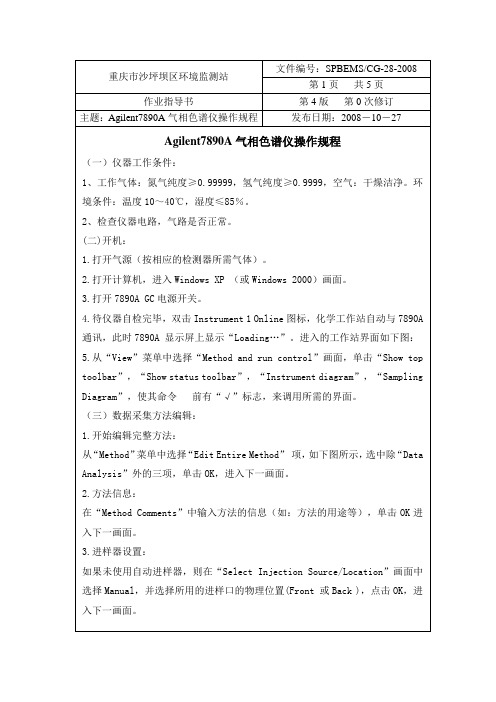
从“Method”菜单中选择“Edit Entire Method” 项,如下图所示,选中除“Data Analysis”外的三项,单击OK,进入下一画面。
2.方法信息:
在“Method Comments”中输入方法的信息(如:方法的用途等),单击OK进入下一画面。
3.进样器设置:
6.阀参数设定:
单击“valve”图标,进入阀编辑画面。若阀由于气体进样,在Configure下选择 “Swiching”, 点击“Apply”钮。
7.填充柱进样口参数设定:
单击 “Inlets”图标,进入进样口设定画面。
单击“Apply”上方的下拉式箭头,选中进样口的位置选项(Front 或Back)
如果未使用自动进样器,则在“Select Injection Source/Location”画面中选择Manual,并选择所用的进样口的物理位置(Front 或Back),点击OK,进入下一画面。
如使用自动进样器,则选择GC Injector;若为气体阀进样,则选择7890 GC Valve,同时选中阀的位号。
Lit Offset—点火下限值(2.0PA为缺省值),若显示信号小于输入值,仪器将自动点火,两次点不着,仪器将发生报警信息,并关闭FID气体。编辑完,点击“Apply”钮。
注意:此时必须在主机键盘上开启各气体及检测器。
13.关机:
单击仪器下拉菜单,点击设置GC参数,将FID检测器火焰灭掉,进样口温度、柱温度、Detector温度关掉,待温度降低后再关机、关气。
4.柱参数设定:如下图,点击“Columns”图标,则该图标对应的参数显示出来。在“Columns”下方选择1或2,然后单击“Change…”钮。
- 1、下载文档前请自行甄别文档内容的完整性,平台不提供额外的编辑、内容补充、找答案等附加服务。
- 2、"仅部分预览"的文档,不可在线预览部分如存在完整性等问题,可反馈申请退款(可完整预览的文档不适用该条件!)。
- 3、如文档侵犯您的权益,请联系客服反馈,我们会尽快为您处理(人工客服工作时间:9:00-18:30)。
XXXX 环境监测站
安捷伦7820A 气相色谱仪作业指导书
修改记录
1.目的
为了不断提高和保证全站监测工作质量,规范我站的安捷伦7820A 气相色谱仪操作规程,方便分析人员使用、维护仪器。
2.适用范围
此作业指导书适用于安捷伦7820A
气相色谱仪。
3.操作程序
3.1 开机:
3.1.1.打开气源(按相应的检测器所需气体,FID需要氮气、氢气和空气)。
3.1.2打开计算机,进入Windows界面。
3.1.3打开7820A GC电源开关。
3.1.4待仪器自检完毕,双击“联机”图标,进入化学工作站,化学工作站自动与7820A通讯,建立连接。
3.2 7820A配置编辑
3.2.1点击“配置”按钮。
在“其他”项目中选择压力单位。
3.1.2柱参数设定点击“色谱柱”按钮,进入柱参数设定画面。
点击前面的数字,对该柱的名称、长度、内径、膜厚、最高使用温度、最低使用温度和该柱的类型进行设置;点击该柱下拉式箭头选择连接的进样口,检测器及加热类型;用“↑”和“↓”在各柱之间进行切换。
3.1.3在“模块”项目中选择后进样口和后检测器尾吹气的种类。
4.在“ALS”项目中输入所用自动进样针的规格。
3.3 测试以及数据采集方法编辑:
3.3.1 开始编辑完整方法
从“文件”菜单中选择“新建”→“方法”→“确定”。
3.3.2填写自动进样器的参数:
点击“”,设置进样体积:0.2uL,溶剂A清洗,进样前清洗4次,进样后清洗4次,体积为最大,溶剂B清洗,进样前清洗4次,进样后清洗4次,体积为最大,样品清洗2次,样品抽吸次数6次,驻留时间,进样前:0分钟,进样后:0分钟,推杆速度:快速,粘度延迟:0秒,采样深度:不启用,进样类型:标准 L1气隙 0.2uL。
注:上述设置是常用设置,对于不同性质的样品,需要对某些参数进行更改,比如对于粘度较大的样品,需要将进样后驻留时间设为3-5s,同时将粘度延迟设为3-5s
3.3.3填写进样口参数:
点击“前进样器”或“后进样器”,根据需要填写前进样口或后进样口参数。
输入数值后,在各参数前面打钩。
根据需要设置进样口温度、进样的模式(分流、不分流、脉冲分流和脉冲不分流,毛细管柱一般要分流,填充柱一般不分流)。
载气节省一般要开启。
3.3.4点击“”图标,进入色谱柱设定画面。
控制模式:打开,选择流量模式(恒定压力、梯度压力、恒定流量和梯度流量),选择恒定压力和梯度压力需输入压力值,选择恒定流量和梯度流量需输入流量值。
输入后运行流量或者压力。
3.3.5柱温箱温度参数设定:
点击“”图标,进入柱温箱参数设定。
设置柱温箱温度为开,在空白框内
输入初始温度,保持时间,升温(降温)速率,所需温度1,保持时间1,......,输入平衡的时间。
3.3.6 FID检测器参数设定:
点击“”图标,进入检测器参数设定。
勾选加热器、空气流量、氢气燃气流量、尾吹气流量和火焰,输入加热器、空气流量、氢气燃气流量和尾吹气流量的值。
3.3.7点击“”,选择后部信号(FID),选择数据采集频率/最小峰宽为50Hz/0.004min。
3.3.8在触发器选项中选择触发器类型为“外部”。
3.3.9从“文件”菜单中选择“保存”→“方法”,填写文件名,选择方法保存的位置,最后点击“保存”。
3.4 序列编辑及运行序列
3.4.1在“文件”菜单中选择“新建”→“序列”→“确定”。
3.4.2输入重复次数、样品瓶位置(对于1号必须填201,其余类推)、样品ID 和文件名,选择测试方法。
3.4.3从“文件”菜单中选择“保存”→“序列”,填写文件名,选择序列保存的位置,最后点击“保存”。
3.4.4单击序列运行,选择结果路径和运行范围,输入结果名称,点击“开始”。
3.5数据分析方法编辑:
3.5.1双击“联机”图标,选择离线打开。
3.5.2从“文件”菜单中选择“打开/方法”加载一个方法。
3.5.3从“文件”菜单,选择“打开/数据”加载一个数据文件。
3.5.4设置积分事件
(1)左击积分事件,然后弹出一个带积分事件的谱图。
(2)点击“事件”栏并选择“宽度”命令,在这个命令前打钩激活它。
并输入相应的值。
(3)点击“事件”栏并选择“阈值”命令。
在这个命令前打钩激活它。
并输入相应的值。
3.5.5打印报告:
(1) 通过导航面板,点击“方法”下的“报告”按键。
(2) 弹出一个空白的模板。
(3) 点击鼠标右键并选择“导入报告”。
(4) 根据需要选择“面积归一法或者外标法...”。
并根据需要设置报告模板,加入页眉页脚等参数。
(5) 保存方法,右击选择打印,选择纸张大小,点确定后,选择方法报告保存
的位置,点创建。
3.6关机
3.6.1实验结束后,先将进样口、柱温和检测器降温,并将氢气和空气关闭。
3.6.2待各处温度降到50℃以下后,关闭工作站,退出Windows所有的程序。
3.6.3关闭电脑,关闭打印机电源。
4. 关7820A电源,最后关载气。
3.7仪器日常维护
3.7.1气体及载气过滤器
每日检查钢瓶压力,当气瓶余压为2MPa左右时,则需要更换气瓶。
水分净化器和水分/氧气净化器主要的作用是过滤载气中的水气和氧气。
水分净化器通过筛管中填料的颜色来分析过滤器是否达到使用极限,平时注意观察一下即可。
水分/氧气净化器最好一年换一次。
3.7.2进样针
进样针在使用一段时间后,需取下用甲醇和丙酮清洗,用进样针反复抽吸清洗溶剂,清洗完毕后放在烘箱(60°左右)中烘干。
为了保证针正常,需要手动清洗。
清洗时切勿将整一支针放在清洗溶剂中!
3.7.3进样瓶
使用过后的进样瓶,需将里面的溶液倒掉,然后用10%的硝酸浸泡进样瓶(需
将瓶盖上的隔垫取下来一起清洗,进样瓶需装满10%硝酸),在超声半小时,然后用纯水清洗,再用1:1丙酮水溶液浸泡进样瓶(进样瓶需装满丙酮水溶液),在超声半小时,然后用纯水清洗,后用纯水浸泡进样瓶(进样瓶需装满纯水),在超声半小时,然后再用纯水清洗三次即可,最后放在烘箱中干燥(60°左右)。
3.7.4洗针溶剂瓶及废液瓶
做样前应检查洗针溶剂瓶中溶剂是否足够,在给洗针溶剂瓶中添加溶剂的同时,顺便将废液瓶中的废液倒掉,以免洗针溶剂瓶中的废液累积过多而未及时清洗。
往洗针溶剂瓶中添加溶剂前先用溶剂清洗3次,然后再装溶剂。
洗针溶剂瓶及废液瓶的清洗按进样瓶的清洗方法清洗。
3.7.5进样垫
进样垫通常在自动进样150次或手动进样50次时就开始换新的进样垫,对于进样垫的更换,如果GC处于开机状态需做以下几步:
(1)将柱箱、进样口和检测器温度降到50°,然后再将载气流速调为零
(2)逆时针拧开盖子
(3)用镊子取出旧进样垫,换上新的进样垫,用手压紧,盖上盖子,把盖子拧紧后,再拧松1/4-1/2圈(可避免进样垫形成打孔效应)。
如果进样口的盖子拧得过紧,垫片失去弹性,则会形成打孔效应,易漏气。
3.7.6衬管
衬管通常在自动进样150次后也需要进行更换,玻璃棉的位置在衬管的中间,最好每次都保持在同一位置。
装衬管时应按“↓”方向安装,果GC处于开机状态需做以下几步:(1)将柱箱、进样口和检测器温度降到50°,然后再将载气流速调为零
(2)用工具逆时针拧开进样口中间的盖子,移开进样口上部分,用镊子取出衬管
(3)取下旧的“O”形圈,套到新的衬管上(“O”形圈可重复使用几次),将衬管按“↓”方向放入进样口中,用手轻压衬管上端,直到不能再压下去为止。
盖上进样口中间的盖子。
清洗:将待清洗的衬管浸泡在装有丙酮的比色皿中,超声半小时,然后用纯水清洗,清洗完毕后放在烘箱(60°左右)中烘干。
3.7.7色谱柱
色谱柱在使用一段时间后,需要清洗和老化,以去除色谱柱中残留的物质,清洗的方法就是手动注入丙酮和正己烷。
新柱的老化最好不要接检测器。
4.相关文件
操作中所涉及的内容参见仪器产品说明书。
5.记录
使用与维护记录见附录。
